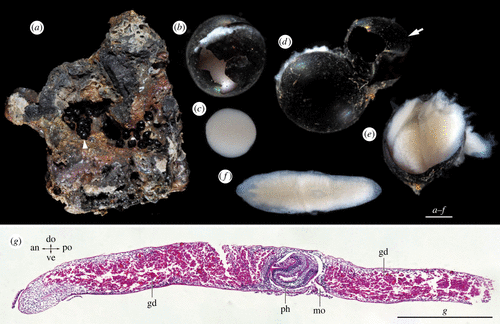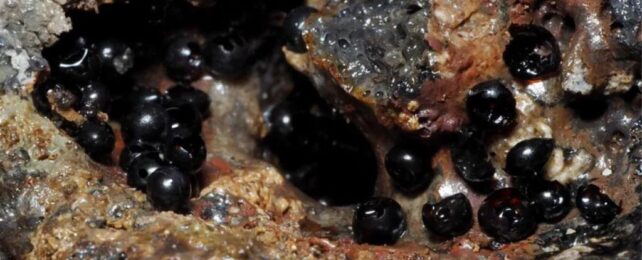A clutch of tiny black eggs, discovered by a remotely operated vehicle in the abyss of the Pacific Ocean, is the first concrete evidence that deep-sea flatworms exist more than 6,000 meters (3.7 miles) deep.
At first, when the undersea vehicle shone its light on the mysterious black spheres, researchers at the University of Tokyo in Japan didn't know what they were looking at.
Marine researcher Yasunori Kano, who was operating the ROV that day, was intrigued, and he decided to retrieve the capsules from their resting place around 6,200 meters (20,341 feet or 3.85 miles) deep in a trench of the northwest Pacific.
Once out of the water, Kano noticed that most of the black spheres were attached to rock and were torn and empty. He sent four intact ones to Hokkaido University invertebrate biologists, Keiichi Kakui and Aoi Tsuyuki.
Upon examination, the duo found each leathery casing, or 'cocoon', was roughly 3 millimeters wide and contained three to seven developing flatworms.
"When we opened the egg capsules, a milky liquid … that might have been yolk was observed along with the flatworms," write Kakui and Tsuyuki in their paper.

Sampling the DNA of the worm embryos, the duo found they belonged to an undescribed and unnamed species of platyhelminth, most closely related to two suborders that exist in shallower waters.
Kakui told Rachel Funnell of IFLScience that when he received the eggs from Kano, he didn't realize how rare they were.
The embryos looked "indistinguishable" from shallow-water flatworms.
All flatworms are hermaphrodites, meaning they can produce both male and female gametes. Shallow water species reproduce sexually by laying eggs in leathery cocoons, which are usually attached to a substrate.
Today, scientists know next to nothing about deep-sea, free-living flatworms, let alone how they reproduce. Prior to this discovery, the deepest evidence of a 'potential platyhelminth' was found on a piece of sunken wood just over 5,200 meters deep.
Not only was this creature not confirmed as a flatworm, it was unclear if the wood sank with a shallow-water species, or if a deep-sea flatworm found the wood after it sank.
The deepest ocean flatworm that was confirmed prior to this discovery was found at a depth of 3,232 meters.
"This study provides the deepest record for free-living flatworms and the first information on their early life stages in the abyssal zone, which were very similar to those in shallow-water forms," conclude Kakui and Tsuyuki.
The eggs appear to have been laid by at least two adults of the same species. Given that the embryos were at different stages of development when retrieved from the deep seabed, the cocoons were probably laid over time, not all at once.
Given the similarities to shallow-water flatworms, the results suggest that these creatures may have colonized deeper and deeper habitats over time.
Why they did so and how they did so remains a mystery.
The study was published in Biology Letters.
